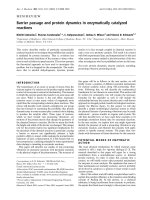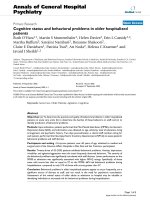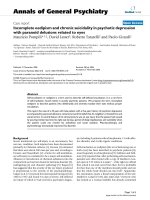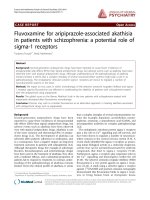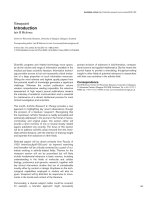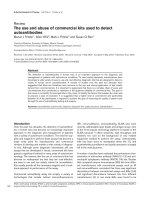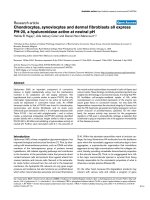Báo cáo y học: "Suicide attempts and related factors in patients admitted to a general hospital: a ten-year crosssectional study (1997-2007)" pot
Bạn đang xem bản rút gọn của tài liệu. Xem và tải ngay bản đầy đủ của tài liệu tại đây (274.19 KB, 10 trang )
RESEARCH ARTICLE Open Access
Suicide attempts and related factors in patients
admitted to a general hospital: a ten-year cross-
sectional study (1997-2007)
Jesús Alberdi-Sudupe
1*
, Salvador Pita-Fernández
2
, Sonia M Gómez-Pardiñas
1
, Fernando Iglesias-Gil-de-Bernabé
1
,
Jorge García-Fernández
1
, Gonzalo Martínez-Sande
1
, Sara Lantes-Louzao
1
and Sonia Pértega-Díaz
2
Abstract
Background: Suicide and suicide attempts represent a severe problem for public health services. The aim of this
study is to determine the socio-demographic and psychopathological variables associated with suicide attempts in
the population admitte d to a General Hospital.
Methods: An observational-descriptive study of patients admitted to the A Coruña University Hospital (Spain)
during the period 1997-2007, assessed by the Consultation and Liaison Psychiatric Unit. We include n = 5,234
admissions from 4,509 patients. Among these admissions, n = 361 (6.9%) were subsequent to a suicide attempt.
Admissions arising from a suicide attempt were compared with admissions occurring due to other reasons.
Multivariate generalised estimating equation logistic regression models were used to examine factors associated
with suicide attempts.
Results: Adjusting by age, gender, educational level, cohabitation status, being employed or unemployed, the
psychiatric diagnosis at the time of the interview and the information on previous suicide attempts, we found that
the variables associated with the risk of a suicide attempt were: age, psychiatric diagnosis and previous suicide
attempts.
The risk of suicide attempts decreases with age (OR = 0.969). Psychiatric diagnosis was associated with a higher risk
of suicid e attempts, with the highest risk being found for Mood or Affective Disorders (OR = 7.49), followed by
Personality Disorders (OR = 7.31), and Schizophrenia and Other Psychotic Disorders (OR = 5.03).
The strongest single predictive factor for suicide attempts was a prior history of attempts (OR = 23.63).
Conclusions: Age, psychopathological diagnosis and previous suicide attempts are determinants of suicide
attempts.
Background
Suici de attem pts constitute a serious problem for public
healthcare services [1- 3]. The dat a published on suicide
attempts in Spain are scant [4,5], and no data are avail-
able on patients admitted to General Hospitals in our
public healthcare setting after a suicide attempt.
Suicidal behaviour not only includes suicides, but also
those suicide attempts which do not result in the
patient’ s death. Mental phenomena, such as suicidal
impulses or unconsummated ideations can also be
included,aswellasawiderangeofbehaviourswhich
are pernicious to the patient’s health without a previous
explicit declaration of a suicidal intention [6,7].
A variety of factors are associated with an increased
risk of suicide and attempted suicide [8], including psy-
chiatric disorders [9-14], feelings of hopelessness and
impulsivity [15,16], h istor y of previo us suicide at tempt s
[9,17,18], age, sex and race [19-24], marital status
[25,26], occupation [27], com orbidity [28,29], adverse
childhood experiences [30], family history [31,32], and
accessibility to weapons, especially firearms [33].
* Correspondence:
1
Department of Psychiatry, A Coruña Hospital, UPIE Planta Baja, Hospital de
Oza, As Xubias, 84, 15006 A Coruña, Spain
Full list of author information is available at the end of the article
Alberdi-Sudupe et al. BMC Psychiatry 2011, 11:51
/>© 2011 Alberdi-Sudupe et al; licensee BioMed Central Ltd. This is an Open Access article distributed under the t erms of the Creative
Commons Attribution License ( which permits unrestricted use, distribution, and
reproduction in any mediu m, provided the original work is properly cited.
A recent paper [34] highlights the simi larities and dif-
ferences among hete rogeneous groups of patients, some
of whom committed suicide, and others who survived the
attempt. The authors conclude that depressive symptoms
are present in both groups as a shared variable.
Some of the individuals who attempt to commit sui-
cide (by physically inflicting self-harm o r ingesting a
product at toxic dose levels) are taken to the Emergency
Departments o f General Hospitals, while others remain
in their family or social environment after the attempt,
with no specific health care; no official statistics on
attempted suicides are available.
A proportion of these attending Accident and Emer-
gency Departments will be admitted t o the General
Hospital’s Medical an d Surgical Departments, owing to
the surgical lesions and medical comorbidity present
after the suicide attempt. In this paper, we study
patients admitted to a General Hospital, serving a health
area with a population of 500,000, who required hospital
admission, and for whom psychiatric assessment by the
Consultation and Liaison Psychiatric Unit was
requested, over an 11-year period (1997-2007). The aim
of the present study was to determine the variables asso-
ciated to suicide attempts in this group of admissions.
Methods
Setting and patients
The patients successively admitted to the A Coruña hos-
pital between 1997 and 20 07, with the exception of
those admitted to the Department of Psychiatry, who
required attention from the Consultation and Liaison
Psychiatric Unit at the request of the appropriate Medi-
cal or Surgical Unit.
Design
An observational-descriptive study of prevalence, using
the hospital records of the patients attended. Admis-
sions due to attempted suicide were compared with
admissions for other reasons.
Inclusion criteria
Patients admitted to the hospital during the study per-
iod, and for whom psychiatric assessment by the Con-
sultation and Liaison Psychiatric Unit was requested.
Exclusion criteria
Patients who were admitted directly to the Department
of Psychiatry after assessment in the Emergency
Department.
Measures
For every patient include d in the study, the following
variabl es were ass essed: age, gende r, marital and cohabi-
tation status, educational level, referring hospital
department, profession, occupational situation, psychia-
tric diagnosis with the psychiatric interview (in line with
DSM-IV and ICD-10 criteria), medical and surgical risk
at the time of the psychiatric assessment, psychiatric
personal and family background, therapeutic interven-
tion during hospital admission, including the prescribed
pharmacological treatment and psychotherapy.
Sample size justification
The sample size (n = 5,234 admissions) makes it possi-
ble for the parameters of interest to be estimated with a
confidence of 95% (a = 0.05) and a precision of ± 1.35%.
Statistical analysis
The quantitative variables are expressed as mean ± stan-
dard deviation (SD); the qualitative variables are
expressed as an absolute value (n) and the percentage,
with the estimation of the 95% confidence interval (CI).
Comparisons for quantitative variables were made
with the Student-T or Mann Whitney test, depending
on which was appropriate subsequent to the verification
of normality using the Kolgomorov-Smirnov test.
Qualitative variables associations were analysed using
the Pearson Chi-Square test.
As some patients were admitted on multiple occa-
sions, i ndepen dent variables (i.e. demographic and clini-
cal characteristics) may represent the sa me individual,
giving rise to a lack of independence. In order to
acco unt for the correlated nature of these data, general -
ised estimating equa tions were used to assess associa-
tions between demographic and c linical characteristics
and hospitalisation for suicide attempts [35]. Multivari-
ate generalised estima ting equation logistic regression
models were used to examine factors associated with
suicide attempts. The area under the ROC curve (AUC)
was computed as a measure of model validity. All statis-
tical analyses were performed using SPSS 17.0 and R
2.10.0, in addition to the Geepack package [36].
Ethical-legal aspects
Aut horisation was requested from the Clinical-Research
Ethics Committee (CEIC) and confidentiality was pre-
served in accordance with the current Spanish Data Pro-
tection Law (15/1999).
Results
Descriptive study
The population under study consists of patients
admitted to the Medical and Surgical Depart ments of
the Complexo HospitalarioUniversitarioACoruña
(CHUAC), assessed by the Consultation and Liaison
Psychiatric Unit of the Department of Psychiatry.
The analysis was conducted with hospitalisation as the
unit of analysis. We include n = 5,234 admissions from
Alberdi-Sudupe et al. BMC Psychiatry 2011, 11:51
/>Page 2 of 10
4,509 patients. This means that 725 (16.1%) were read-
missions, some concerning the same patients.
Among the admissions occu rring during the research
period (1997 to 2007), n = 361 (6.9%) were subsequent to
a suicide attempt. 58.4% of the suicide attempts were com-
mitted by women. Patients admitted subsequent to a sui-
cide attempt were younger than those admitted for other
reasons (42.5 ± 17.8 vs. 51.5 ± 18.1 years of age; p < 0.001)
The general features of the patients assessed, accord-
ing to the presence or absence of suicide attempts, are
shown in Table 1.
Univariate analysis
In the univariate analysis, the variables significantly
associated with suicide attempts were: age, gender, mari-
tal and cohabitation status, employment status, educa-
tional level, the psychiatric diagnosis according to DSM-
IV-TR criteria (ICD-10 codes) and previous suicide
attempts (Table 1).
Globally, the group of patients who attempted a sui-
cide was significantly (p < 0.05) younger than the group
of patients who had not (42.5 years o f age vs. 51.5 years
of age). There was also a higher percentage of women
in the suicide attempt group than in the non-suicide
attempt group (58.4% vs. 45.7%).
With regard to marital status, the percentages of sin-
gle (40.4% vs. 28.0%) and separated individuals (13.6%
vs. 8.1%) were also higher in the suicide attempt group
than in the comparison group.
In relation to the cohabitation status variable, out of
those patients who had made a suicide attempt, the per-
centage living with their parents (22.5% vs. 13.9%) or
other relatives (15.3% vs. 9.7%) was higher than in the
comparison group. The percentage of patients living
with a partner and children was lower in the suicide-
attempt group than in the non-suicide attempt group
(38.6% vs. 52.6%).
The percentage of e mployment in the suicide attempt
group is higher than in the other group of patients
(49.6% vs. 32.8%), and higher educational levels were
found in those attempting suicide attempt th an in the
other group.
With regard to grouped diagnosis, in accordance with
the DSM-IV-R categories formulated with ICD-10
codes, a higher prevalence of psychiatric disorders was
found i n the suicide attempt group (12.3% vs. 5.7% for
Psychotic Disorders, 29.5% vs. 11.1% for Mood of Affec-
tive Disorders, 24.2% vs. 5.4% for Personality Disorders).
There was also a higher prevalence of previous suicide
attempts in the suicide attempter group than in the
comparison group (9.1% vs. 0.1%).
In the univariate analysis, the variables not associated
withtheriskofattemptedsuicideweretheprovinceor
domicile and the year of participation in the study.
Multivariate analysis
A multivariate generalised estimating equation logistic
regression model was performed, taking into account all
the variables significantly associated with suicide
attempts in the univariate analysis.
Table 1 General features of the episodes attended
according to presence or absence of suicide attempt
No suicide
attempt
Suicide
attempt
Mean SD Mean SD p
Age 51.5 18.1 42.5 17.8 < 0.001
n%n% p
Gender < 0.001
Men 2647 54.3 150 41.6
Women 2226 45.7 211 58.4
Marital Status < 0.001
Single 1356 28.0 146 40.4
Married 2529 52.3 138 38.2
Separated 394 8.1 49 13.6
Widowed 536 11.1 25 6.9
Religious 7 0.1 2 0.6
Others 18 0.4 1 0.3
Cohabitation status < 0.001
Alone 649 13.4 48 13.3
Partner and children 2556 52.6 139 38.6
Parents 673 13.9 81 22.5
Alone with children 330 6.8 22 6.1
With other relatives 472 9.7 55 15.3
Institution 90 1.9 7 1.9
Others 69 1.4 7 1.9
Homeless 18 0.4 1 0.3
Employment < 0.001
No 3249 67.2 181 50.4
Yes 1584 32.8 178 49.6
Educational level 0.013
No Education 825 17.2 40 11.3
Primary and Secondary
Education
3587 74.8 281 79.2
Higher and University
Education
385 8.0 34 9.6
DSM-IV-TR grouped diagnosis
with
ICD-10 codes
< 0.001
Schizophrenia and other
Psychotic Disorders (333). F20-
F29
274 5.7 44 12.3
Mood or Affective Disorders
(387). F30-39
533 11.1 106 29.5
Personality Disorders (765). F60 259 5.4 87 24.2
Other Diagnosis 3728 77.8 122 34.0
Previous suicide attempts < 0.001
No 4866 99.9 328 90.9
Yes 7 0.1 33 9.1
Alberdi-Sudupe et al. BMC Psychiatry 2011, 11:51
/>Page 3 of 10
Adjusting by age, gender, educational level, cohabita-
tion status, employment status, the psychiatri c diagnosis
at the mo ment of the inter view, and the information on
previous suicide attempts, we found that the variables
associated with the risk of making a suicide attempt
were: age, psychiatric diagnosis and previous suicide
attempts. The area under the ROC curve (AUC), as a
measure of model validity, was 0.805.
The risk of suicide attempt decreases with age (OR =
0.969), while psychiatric diagnosis was as sociated with a
higher risk of suicide attempts: the highest risk was
found for Mood or Affective Disorders (OR = 7.49), fol-
lowed by Personality Disorders (OR = 7.31), and Schizo-
phrenia and Other Psychotic Disorders (OR = 5.03).
The strongest single factor predictive of suicide
attempt was a prior history of attempted suicide (OR =
23.63) (Table 2).
After stratifying by gender (Table 3), the variables
associated with the presence of suicide attempt for both
sexes were age, psychiatric diagnosis and previous sui-
cide attempts.
The relationship between age, psychiatric diagnosis
and the probability of suic ide attempts according to
gender in the multivariate analysis can be seen in
Figures 1 and 2.
Among men, the psychiatric diagnosis with the highest
risk for suicide attempts was Personality Disorders (OR
= 7.18), followed by Affective Disorders (OR = 6.18) and
Schizophrenia and Other Psychotic Disorders (OR =
4.15).
Among women, Affec tive Disorders (OR = 8.65), in
the first place, followed by Personality Disorders (OR =
7.58) and Schizophrenia and Other Psychotic Disorders
(OR = 6.38) were found to be associated to a higher risk
of suicide attempts.
The strongest predictive factor of attempted suicide in
both men and women was previous suicide attempts
(Table 3).
Discussion
The present study evidences that the variables associated
to suicide attempts are age, psychiatr ic comorbidity and
previous suicide attempts. These findings are referre d to
in the previous literature; hence, this study, carried out
on hospital pati ents, reflects the consistency o f the
results in the previously described variables [2,37-39].
The association of psychiatric illness as a predictor of
suicide attempts has been reported in the literature
[9,10]. More than 90% of patients who attempt suicide
have a major psychiatric disorder [11,12], and 95% of
patients who committed a suicide attempt had a psy-
chiatric diagnosis [13]. A very recent project [40] from
the W orld Health Organisation (WHO) produced
results on the association between the diagnosis of Men-
tal Disorders and Suicidal Behaviours in several coun-
tries (including Spain), supported by worldwide data
obtained from su rveys in ge neral populations (108,664
people from 21 countries on five continents answered
the surveys). One of its conclusions is that the presence
of a psychiatric diagnosis with DMS-IV Mental Disorder
criteria is a strong predictor for the appearance of sui-
cide ideations and behaviours, as well as for consum-
mated suicide. This applies generally to both
economically developed countries and to developing
countries, except for one important difference: among
the Mental Disorders associated with higher suicide risk,
Table 2 Multivariate generalised estimating equation logistic regression model for predicting a suicide attempt
adjusting for different variables and previous suicide attempts
Regression coefficient Standard error p OR 95% CI (OR)
Intercept -2.316 0.287 < 0.001
Age -0.031 0.004 < 0.001 0.969 0.961-0.977
Gender (Female) 0.120 0.127 0.100 1.223 0.962-1.560
Educational level
Illiterate 1
Secondary education 0.154 0.204 0.448 1.167 0.783-1.739
Higher education 0.439 0.257 0.088 1.552 0.937-2.570
Living alone 0.051 0.180 0.778 1.052 0.739-1.497
Employed 0.145 0.188 0.441 1.156 1.800-1.670
Psychiatric disorders
Psychotic disorders 1.615 0.202 < 0.001 5.030 3.387-7.470
Affective disorders 2.014 0.154 < 0.001 7.490 5.537-10.132
Personality disorders 1.989 0.169 < 0.001 7.310 5.249-10.180
Other diagnosis 1
Previous suicide attempt 3.162 0.534 < 0.001 23.630 8.290-67.360
OR: Odds Ratio; CI: Confidence Interval.
Alberdi-Sudupe et al. BMC Psychiatry 2011, 11:51
/>Page 4 of 10
Affective Disorders stand out in developed countries,
while the association is higher with diagnoses other than
Affective Disorders, such as Impulse-Control Disorders,
Substance Use Disorders and Post-Traumatic Stress Dis-
orders, in developing countries.
In a large sample of patients in Sweden [10], the authors
concluded that the category of psychiatric diagnosis coex-
isting with a suicide attempt is a variable which influences
the future risk of consummated suicide. Planned reduction
of the risk of future suicide among those patients requires
implementing care plans, mainly in the first two years fol-
lowing the current suicide attempt, in particular among
those patients diagnosed with Unipolar and Bipolar Affec-
tive Disorder, and Schizophrenia.
Although the risk of suicide increases with age, it has
been d emonstrated that in young adul ts, suicide
attempts are more frequent than in older adults [19,20].
These findings, in relation with age, are consistent with
those of the present study. In a study of 10,892 suicides
and 57,439 attempted suicides among hospital-admitted
individuals in 8 states, groups with high attempted sui-
cide rates were teenagers, young adults, women, and
people of Caucasian and Afro-American origin aged 25
to 44 years [19]. Another study in Korea with 344
attempted suicides found that a significantly higher
number of women than men were admitted to emer-
gency rooms due to attempted suicide during t he study
period [21]. In a random sample of 3021 adolescents
aged 14-24 years, the females who attempted suicide
showed suicidal thoughts and suicide attempts signifi-
cantly more often, and suicide attempts at a far younger
age than the males [23].
A systemati c review of studies on the epidemiol ogy of
suicide published from 1997 to 2007 showed that non-
Table 3 Multivariate generalised estimating equation logistic regression model for predicting a suicide attempt after
stratifications according to gender
Men
Regression coefficient Standard error p OR 95% CI (OR)
Intercept -2.737 0.488 < 0.001
Age -0.032 0.006 < 0.001 0.968 0.956-0.980
Educational level
Illiterate 1
Secondary education 0.702 0.415 0.091 2.017 0.894-4.551
Higher education 0.959 0.470 0.041 2.609 1.039 -6.550
Living alone 0.266 0.235 0.258 1.304 0.823-2.068
Employed -0.016 0.288 0.956 0.984 0.560-1.732
Psychiatric disorders
Psychotic disorders 1.424 0.283 < 0.001 4.154 2.387-7.231
Affective disorders 1.822 0.259 < 0.001 6.182 3.722-10.269
Personality disorders 1.971 0.244 < 0.001 7.183 4.449-11.597
Other diagnosis 1
Previous suicide attempt 3.977 0.659 < 0.001 53.387 14.662 -194.388
Women
Regression coefficient Standard error p OR 95% CI (OR)
Intercept -1.997 0.384 < 0.001
Age -0.031 0.006 < 0.001 0.969 0.958-0.980
Educational level
Illiterate 1
Secondary education -0.065 0.248 0.790 0.937 0.576-1.525
Higher education 0.250 0.342 0.460 1.285 0.657-2.512
Living alone -0.203 0.285 0.480 0.817 0.467-1.428
Unemployed 0.301 0.252 0.230 1.351 0.825 -2.213
Psychiatric disorders
Psychotic disorders 1.854 0.286 < 0.001 6.385 3.645-11.184
Affective disorders 2.157 0.200 < 0.001 8.648 5.858-12.769
Personality disorders 2.026 0.240 < 0.001 7.582 4.738 -12.133
Other diagnosis 1
Previous suicide attempt 2.830 0.656 < 0.001 16.947 4.684-61.313
OR: Odds Ratio; CI: Confidence Interval.
Alberdi-Sudupe et al. BMC Psychiatry 2011, 11:51
/>Page 5 of 10
fatal suicidal b ehaviours are more prevalent among
women and young, unemployed, unmarried individuals,
with low levels of education and suffering from a psy-
chiatric disorder [1]. Our results are consistent in rela-
tion with age, gender and psychiatric disorders, but they
do not coincide with the aforementioned study with
regard to the variables of educational level and unem-
ployment. In the univariate a nalysis we f ound a higher
rate of suicide attempts among working populations,
and with higher educational levels. The utilisation of
health care services is probably related to socioeconomic
status and educational level. Nonetheless, owing to the
fact that we only have information on those patients
who finally went to the hospital, we cannot make infer-
ences regarding this point. In the multivariate general-
ised estimating equation logistic regression analysis, the
association with educational level and employment
disappears.
The variable most strongly associated with suicide
attempts in the study is that of a prior history of
Figure 1 Relationship between probability of suicide attempt, age and grouped diagnosis in women.
Figure 2 Relationship between probability of suicide attempt, age and grouped diagnosis in men.
Alberdi-Sudupe et al. BMC Psychiatry 2011, 11:51
/>Page 6 of 10
attempted suicide. Ecological studies showed a positive
correlation between rates of attempted suicide and sui-
cide rates for both sexes among young people in Europe
[41]. Prospective monitoring studies of pa tients hospita-
lised as a result of a suicide attempt show that the risk
of suicide and all causes of mortality were very high
immediately after discharge [9]. In a systematic review
of data published on the following -up of patients subse-
quent to failed suicide attempts [42], the authors found
that, in a one-year follow-up period subsequent to the
failed suicide attempt, the repeat attempt rate was15%.
There is a strong correlation between suicide attempt
and subsequent death by suicide. In a study of a group
of patients who attended the General Ho spital after a
self-harm episode, the presence of previous s elf-harm
episodes is a risk factor for the onset of future suicidal
behaviours [6]. This implies that outpatient care a fter
attempted suicide is of paramount importance. Despite
this fact, the identification of specific individuals who
will go o n to at tempt and consummate suicide is cu r-
rently unfeasible, owing to the scant sensitivity and spe -
cificity of the identification procedures available, and the
low base rate of this behaviour [17,18].
Similar findings with respect to age, sex and previous
suicide attempts have been reporte d in other publica-
tions. Thus, a study on a European level shows how the
person-based suicide attempt rates were higher among
women than among men and the highest person-based
rates were found in the younger age groups [37]. More-
over, more than 50% of the i ndividuals attempting sui-
cide made more than one attempt [37]. Another study
shows connection between suicide attempts and the
individuals in the youngest age group, who reported sui-
cidal ideation at baseline and psychiatric disorders, espe-
cially depression and d rug abuse [38]. A systematic
sample of 114 patients from consecutive cases of
attempted suicide referred to a general hospital in Hel-
sinki shows that a high proporti on of individuals
attempting suicide (82%) suffered from comorbid mental
disorders [39].
In turn, in a population-based study conducted in
Spain [2] among young women, mental disorders and
psychiatric comorbidity and recent ideation of suicide
were identified as high risk factors for an attempted sui-
cide. Episodes of severe depression are the diagnosis
representing the greatest risk in relation to the presence
of the ideation of suicide and attempted suicide.
In relation with the differences found between men
and women, the literature shows that a history of sui-
cide attempt is significantly associated with any anxiety,
personality, or substance use disorder among both men
and women. However, in men, suicide attempts had a
strong association with dependent personality disorder
(adjusted odds ratio = 3.81; 95% CI = 1.14 to 12.73),
whereas in women, suicide attempts had a strong asso-
ciation with antisocial personality disorder (adjusted
odds ratio = 2.71; 95% CI = 1.72 to 4.25) [43].
Limitations of the study
The present study has a number of shortcomings and
biases, w hich we will now go on to point out.
Attempted suicide is more difficult to study than con-
summated suicide, as there is a lack of generally
approved reporting procedures for the former [44]. The
possibility of a certain degree of under-reporting of
attempted suicide in the present study cannot be
excluded.
Another selection bias is associated with the use of
hospital patients as a comparison group for identifying
risk factors associated with suicide attempts.
The study is clearly conducted on admitted patients,
some of whom are admitted owing to attempted suicide
and o thers who are not (comparison group). Thus, the
inference is not intended to be the general population,
rather the sub-set of patients who are admitted to hos-
pital. Nonetheless, given the magnitude of the problem
in this sub-set of patients, we feel that it is relevant to
be able to define the variables associated with the
attempted suicide, while clear ly accepting that these are
patients who have been admitted for medical-surgical
problems.
Given that the controls used in the hospital study are
patients who also suffer from psych iatric disorders, we
are aware of the presence of Berkson’ s bias [45,46],
which occurs when hospital controls are used as a refer-
ence group. If the contr ols are hospitalised due to an
exposure that is also related to the dis ease under study,
then the measure of effect may be weakened; i.e. biased
towards the null hypothesis of no association. This pro-
duces a systematically higher exposure rate among the
comparison group, an therefore distorts the odds ratio
with an underestimation of the suicide attempt risk. In
this sense, we can confirm that the odds ratios asso-
ciated with the mental disorder in the present study are
lower than those that could be obtained in a popula-
tion-base study. This has been confirmed by comparing
the results of the pre sent study with the popu lation-
based study by Gabilondo et al. (2007) [2], which shows
how the presence of mental disorders is associated with
a significant increase in at tempted suicides, with higher
odds ratio values than found in the present study, point-
ing towards an underestimation of the risk of attempted
suicide depending on the type of controls used, as could
have been expected.
Despite the underestimation of this effect, our findings
are consistent with those from other studies and meta-
analyses which show how psychi atric illness i s a strong
pred ictor of su icide [9,10,47]. A psy chiatric disorder has
Alberdi-Sudupe et al. BMC Psychiatry 2011, 11:51
/>Page 7 of 10
also been identified as the strongest risk factor for
attempted suicide [48-51]. More than 90 percent o f
patients who attempt suicide have a major psychiatric
disorder [11,12]. Among patients with depression, a his-
tory of suicide att empts correlated most strongly with
feelings of worthlessness [43]. Concurrent personality
disorder was also strongly correlated with suicide
attempts in depressed patients [43].
In relation to previous suicide attempts, we consider
that one explanation for the extremely h igh association
of prev ious suicide attempts with a current suicide
attempt in this study could b e that after the initial
attempt, individuals may tend to stay with their family,
being referred to the hospital more often after a subse-
quent suicide attempt. There may be an association
between attending hospital after a suicide attempt and
repeated suicide attempts. This effect, which is described
as surveillance bias or detection bias, occurs when one
group is monitored more clos ely than the other group,
and it may lead to an outcome being diagnosed more
often in the more closely monitored group, but not
because it actually occurred more frequently in that
group. This association wit h previous suicide attempts
was also identified in a nationwide study in Finland [9],
and in a prospective study [17] in which the authors
found that the strongest single factor for suicide is prior
history of attempt suicide.
There may also be an information bias due to the fact
that the diagnoses of mental disorders were n ot based
on standardised diagnostic interview s chedules, but
instead were clini cal diagnoses made by the psych iatrists
treating the patients.
As a number of patients were admitted on multiple
occasions, the results may be affected by the lack of
independence among admissions. The analysis was con-
ducted with hospitalisation as the unit of analysis,
including 5,234 admissions from 4,509 patients. As pre-
viously mentioned, this means that 725 (16.1%) were
readmissions, some concerning the same patients. To
overcome this problem, the statistical analysis was per-
formed using generalised estimating equations, in order
to take into account the correlated nature of the data.
More specifically, multivariate generalised estimating
equation logistic regression models were used to identify
those variables associated with suicid e attempts [35].
This a nalysis takes into account the fact that the same
patient could be admitted more than o nce during the
study period. Generalised estimating equations are an
extension of the generalised linear model, which takes
into account this within-group correlation. They assume
that the dependent variable of analyses can be expressed
as a linear function of the independent variables through
a monotonic differentiable link function, and that the
variance of the dependent variable is a known function
of its expectation. The parameters of the model are then
estimated subsequent to the specification of the intra-
cluster dependency correlation matrix.
In conclusion, o ur results show that the variables
related to suicide attempt are age, psychiatric disorders
and previous suicide attempts. This study in a hospital
setting shows similar findings to population-based stu-
dies. Even though there is limited evidence as to the
accuracy of screening tools for identifying suicide risk in
the primary care setting, including tools for ident ifying
those at high risk [52], physicians should remain alert to
the possibility of suicide in high-risk patients, particu-
larly if there is evidence of psychiatric disorder or if the
patient has recently attempted suicide.
Conclusions
The variables associated with suicide attempt are age,
previous suicide attempts and certain grouped psychia-
tric diagnosis (Schizophrenia and Other Psychotic Disor-
ders, Affective Disorders and Personality Disorders).
The risk of suicide attempts decreases with age. Psy-
chiatric illness is a strong predictor of suicide attempt.
The strongest single factor predictive of suicide attempts
is a prior history of attempted suicide.
This study in a hospital setting shows similar findings
to population based studies.
Even though there is limited evidence as to the accu-
racy of screening tools for identifying suicide risk in the
primary care setting, including tools for identifying
those at high risk, physicians should remain alert to the
possibility of suicide in high-risk patients, particularly if
there is evidence of ps ychiatric di sorder or if th e patient
has recently attempted suicide
Author details
1
Department of Psychiatry, A Coruña Hospital, UPIE Planta Baja, Hospital de
Oza, As Xubias, 84, 15006 A Coruña, Spain.
2
Clinical Epidemiology and
Biostatistics Unit, A Coruña Hospital, As Xubias, 84, 15006 A Coruña, Spain.
Authors’ contributions
JAS and SGP conceived the study and participated in its design. FIGB, JGF,
GMS and SLL collaborated in the design of the study and data collection.
SPF and SPD participated in the design of the study and performed the
statistical analysis. JAS, SPF and SPD drafted the manuscript. All authors read
and approved the final manuscript.
Competing interests
The authors declare that they have no competing interests.
Received: 24 August 2010 Accepted: 31 March 2011
Published: 31 March 2011
References
1. Nock M, Borges G, Bromet E, Cha C, Kessler R, Lee S: Suicide and suicidal
behavior. Epidemiol Rev 2008, 30:133-154.
2. Gabilondo A, Alonso J, Pinto-Meza A, Vilagut G, Fernández A, Serrano-
Blanco A, Almansa J, Codony M, Haro J: [Prevalence and risk factors for
suicide ideation, plans and attempts in the Spanish general population.
Results from the ESEMeD study]. Med Clin (Barc) 2007, 129(13):494-500.
Alberdi-Sudupe et al. BMC Psychiatry 2011, 11:51
/>Page 8 of 10
3. Hawton K, van Heeringen K: Suicide. Lancet 2009, 373(9672):1372-1381.
4. Tejedor Azpeitia M, Díaz Pérez A, Álvarez Martínez E, Castillón Zazurca J,
Pericay Hosta J: Intento de suicidio: cambios epidemiológicos entre
1969-1996. Estudio retrospectivo de 1.150 casos.;[Attempted suicide:
epidemiological changes between 1969-1996. A retrospective study of
1,150 cases]. Actas Esp Psiquiatr 1999, 27(5):292.
5. Ruiz-Pérez I: El suicidio en la España de hoy. Gaceta Sanitaria 2006,
20(Supl 1):25.
6. Harriss L, Hawton K, Zahl D: Value of measuring suicidal intent in the
assessment of people attending hospital following self-poisoning or self-
injury. Br J Psychiatry 2005, 186:60-66.
7. Skegg K: Self-harm. Lancet 2005, 366(9495):1471-1483.
8. Schreiber J, Culpepper L, Fife A: Suicidal ideation and behavior in adults.
In UpToDate Edited by: Solomon D 2010.
9. Haukka J, Suominen K, Partonen T, Lönnqvist J: Determinants and
outcomes of serious attempted suicide: a nationwide study in Finland,
1996-2003. Am J Epidemiol 2008, 167(10):1155-1163.
10. Tidemalm D, Långström N, Lichtenstein P, Runeson B: Risk of suicide after
suicide attempt according to coexisting psychiatric disorder: Swedish
cohort study with long term follow-up. BMJ 2008, 337:a2205.
11. Moscicki E: Epidemiology of suicide. In Suicide prevention and intervention:
summary of a workshop. Edited by: Goldsmith S. Health IoMBoNaB: National
Academy Press; 2001.
12. Hirschfeld RM, Russell JM: Assessment and treatment of suicidal patients.
N Engl J Med 1997, 337(13):910-915.
13. Litman R: Suicides: What Do They Have in Mind? Suicide: understanding
and responding: Harvard Medical School perspectives 1989, 143.
14. Evenson RC, Wood JB, Nuttall EA, Cho DW: Suicide rates among public
mental health patients. Acta Psychiatr Scand 1982, 66(3):254-264.
15. Beck AT, Steer RA, Beck JS, Newman CF: Hopelessness, depression, suicidal
ideation, and clinical diagnosis of depression. Suicide Life Threat Behav
1993, 23(2):139-145.
16. Dieserud G, Røysamb E, Ekeberg O, Kraft P: Toward an integrative model
of suicide attempt: a cognitive psychological approach. Suicide Life Threat
Behav 2001, 31(2):153-168.
17. Pokorny AD: Prediction of suicide in psychiatric patients. Report of a
prospective study. Arch Gen Psychiatry 1983, 40(3):249-257.
18. Pokorny AD:
Suicide prediction revisited. Suicide
Life Threat Behav 1993,
23(1):1-10.
19. Spicer RS, Miller TR: Suicide acts in 8 states: incidence and case fatality
rates by demographics and method. Am J Public Health 2000,
90(12):1885-1891.
20. O’Connell H, Chin AV, Cunningham C, Lawlor BA: Recent developments:
suicide in older people. BMJ 2004, 329(7471):895-899.
21. Hur JW, Lee BH, Lee SW, Shim SH, Han SW, Kim YK: Gender differences in
suicidal behavior in Korea. Psychiatry Investig 2008, 5(1):28-35.
22. Kumar CT, Mohan R, Ranjith G, Chandrasekaran R: Characteristics of high
intent suicide attempters admitted to a general hospital. J Affect Disord
2006, 91(1):77-81.
23. Wunderlich U, Bronisch T, Wittchen HU, Carter R: Gender differences in
adolescents and young adults with suicidal behaviour. Acta Psychiatr
Scand 2001, 104(5):332-339.
24. Joe S, Baser RE, Breeden G, Neighbors HW, Jackson JS: Prevalence of and
risk factors for lifetime suicide attempts among blacks in the United
States. JAMA 2006, 296(17):2112-2123.
25. Monk M: Epidemiology of suicide. Epidemiol Rev 1987, 9:51-69.
26. Heikkinen ME, Isometsä ET, Marttunen MJ, Aro HM, Lönnqvist JK: Social
factors in suicide. Br J Psychiatry 1995, 167(6):747-753.
27. Stack S: Suicide: a 15-year review of the sociological literature. Part I:
cultural and economic factors. Suicide Life Threat Behav 2000,
30(2):145-162.
28. Juurlink DN, Herrmann N, Szalai JP, Kopp A, Redelmeier DA: Medical illness
and the risk of suicide in the elderly. Arch Intern Med 2004,
164(11):1179-1184.
29. Mukamal KJ, Rimm EB, Kawachi I, O’Reilly EJ, Calle EE, Miller M: Body mass
index and risk of suicide among one million US adults. Epidemiology
2010, 21(1):82-86.
30. Dube SR, Anda RF, Felitti VJ, Chapman DP, Williamson DF, Giles WH:
Childhood abuse, household dysfunction, and the risk of attempted
suicide throughout the life span: findings from the Adverse Childhood
Experiences Study. JAMA 2001, 286(24):3089-3096.
31. Qin P, Agerbo E, Mortensen PB: Suicide risk in relation to family history of
completed suicide and psychiatric disorders: a nested case-control study
based on longitudinal registers. Lancet 2002, 360(9340):1126-1130.
32. Agerbo E: Risk
of suicide and spouse’s psychiatric illness or suicide:
nested case-control study. BMJ 2003, 327(7422):1025-1026.
33. Helmkamp JC: Occupation and suicide among males in the US Armed
Forces. Ann Epidemiol 1996, 6(1):83-88.
34. DeJong T, Overholser J, Stockmeier C: Apples to oranges?: a direct
comparison between suicide attempters and suicide completers. J Affect
Disord 2010, 124(1-2):90-97.
35. Burton P, Gurrin L, Sly P: Extending the simple linear regression model to
account for correlated responses: an introduction to generalized
estimating equations and multi-level mixed modelling. Stat Med 1998,
17(11):1261-1291.
36. Halekoh U, Højsgaard S, Yan J: The R package geepack for generalized
estimating equations. Journal of Statistical Software 2006, 15(2):1-11.
37. Schmidtke A, Bille-Brahe U, DeLeo D, Kerkhof A, Bjerke T, Crepet P,
Haring C, Hawton K, Lönnqvist J, Michel K, et al: Attempted suicide in
Europe: rates, trends and sociodemographic characteristics of suicide
attempters during the period 1989-1992. Results of the WHO/EURO
Multicentre Study on Parasuicide. Acta Psychiatr Scand 1996,
93(5):327-338.
38. Kuo WH, Gallo JJ, Tien AY: Incidence of suicide ideation and attempts in
adults: the 13-year follow-up of a community sample in Baltimore,
Maryland. Psychol Med 2001, 31(7):1181-1191.
39. Suominen K, Henriksson M, Suokas J, Isometsä E, Ostamo A, Lönnqvist J:
Mental disorders and comorbidity in attempted suicide. Acta Psychiatr
Scand 1996, 94(4):234-240.
40. Nock M, Hwang I, Sampson N, Kessler R, Angermeyer M, Beautrais A,
Borges G, Bromet E, Bruffaerts R, de Girolamo G, et al: Cross-national
analysis of the associations among mental disorders and suicidal
behavior: findings from the WHO World Mental Health Surveys. PLoS
Med 2009, 6(8):e1000123.
41. Hawton K, Arensman E, Wasserman D, Hultén A, Bille-Brahe U, Bjerke T,
Crepet P, Deisenhammer E, Kerkhof A, De Leo D, et al: Relation between
attempted suicide and suicide rates among young people in Europe. J
Epidemiol Community Health 1998, 52(3):191-194.
42. Owens D, Horrocks J, House A: Fatal and non-fatal repetition of self-harm.
Systematic review. Br J Psychiatry 2002, 181:193-199.
43. Bolton JM, Belik SL, Enns MW, Cox BJ, Sareen J: Exploring the correlates of
suicide attempts among individuals with major depressive disorder:
findings from the national epidemiologic survey on alcohol and related
conditions. J Clin Psychiatry 2008, 69(7):1139-1149.
44. Alaghehbandan R, Gates KD, MacDonald D: Suicide
attempts and
associated factors in Newfoundland and Labrador, 1998-2000. Can J
Psychiatry 2005, 50(12):762-768.
45. Berkson J: Limitations of the application of fourfold table analysis to
hospital data. Biometrics 1946, 2(3):47-53.
46. Regeer EJ, Krabbendam L, De Graaf R, Have MT, Nolen WA, Van Os J:
Berkson’s bias and the mood dimensions of bipolar disorder. Int J
Methods Psychiatr Res 2009, 18(4):279-286.
47. Bostwick JM, Pankratz VS: Affective disorders and suicide risk: a
reexamination. Am J Psychiatry 2000, 157(12):1925-1932.
48. Beautrais AL, Joyce PR, Mulder RT, Fergusson DM, Deavoll BJ,
Nightingale SK: Prevalence and comorbidity of mental disorders in
persons making serious suicide attempts: a case-control study. Am J
Psychiatry 1996, 153(8):1009-1014.
49. Brent DA, Perper JA, Goldstein CE, Kolko DJ, Allan MJ, Allman CJ,
Zelenak JP: Risk factors for adolescent suicide. A comparison of
adolescent suicide victims with suicidal inpatients. Arch Gen Psychiatry
1988, 45(6):581-588.
50. Mościcki EK, O’Carroll P, Rae DS, Locke BZ, Roy A, Regier DA: Suicide
attempts in the Epidemiologic Catchment Area Study. Yale J Biol Med
1988, 61(3):259-268.
51. Andrews JA, Lewinsohn PM: Suicidal attempts among older adolescents:
prevalence and co-occurrence with psychiatric disorders. J Am Acad Child
Adolesc Psychiatry 1992, 31(4):655-662.
52. Gaynes BN, West SL, Ford CA, Frame P, Klein J, Lohr KN, Force USPST:
Screening for suicide risk in adul ts: a summary of the evidence for the
U.S. Preventive Services Task Force. AnnInternMed2004,
140(10):822-835.
Alberdi-Sudupe et al. BMC Psychiatry 2011, 11:51
/>Page 9 of 10
Pre-publication history
The pre-publication history for this paper can be accessed here:
/>doi:10.1186/1471-244X-11-51
Cite this article as: Alberdi-Sudupe et al.: Suicide attempts and related
factors in patients admitted to a general hospital: a ten-year cross-
sectional study (1997-2007). BMC Psychiatry 2011 11:51.
Submit your next manuscript to BioMed Central
and take full advantage of:
• Convenient online submission
• Thorough peer review
• No space constraints or color figure charges
• Immediate publication on acceptance
• Inclusion in PubMed, CAS, Scopus and Google Scholar
• Research which is freely available for redistribution
Submit your manuscript at
www.biomedcentral.com/submit
Alberdi-Sudupe et al. BMC Psychiatry 2011, 11:51
/>Page 10 of 10
